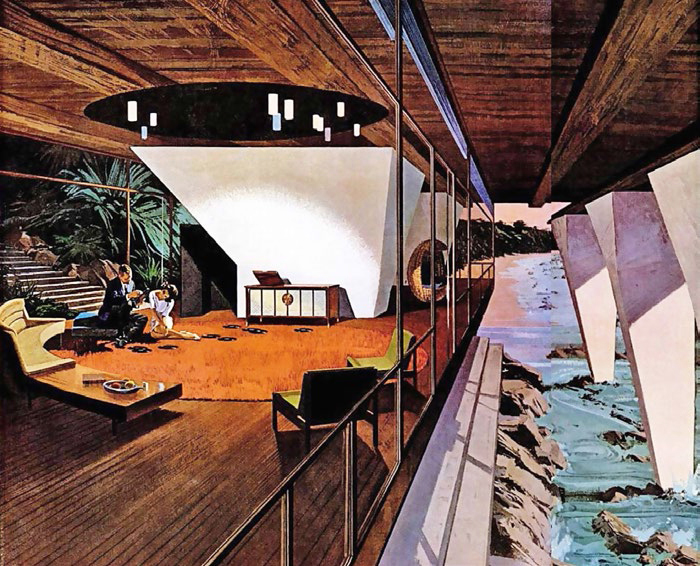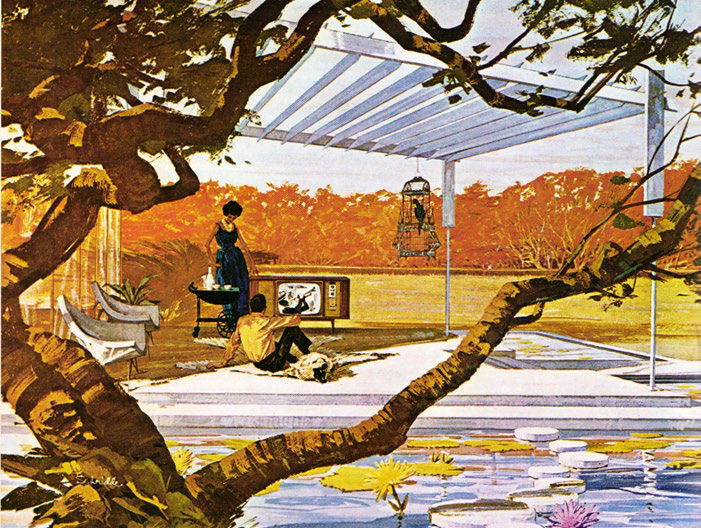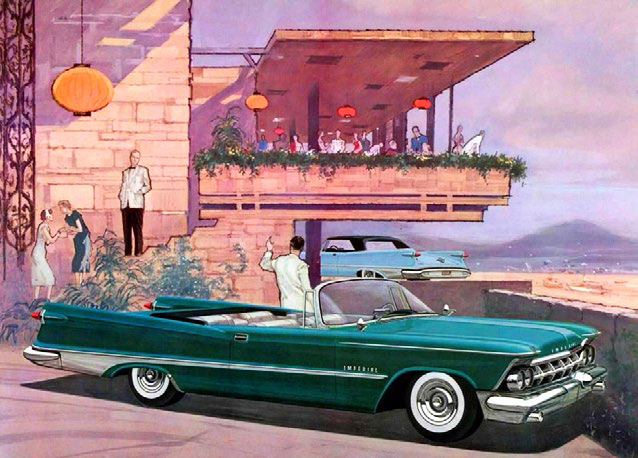Dreamscapes of Elegance - Page 2
 |
|
|
 |
 |
 |
|
|
Surprisingly, according to his daughter, Melanie Schridde, Charles Schridde never expressed interest in modern architecture—though it must be said she was born in 1968, years after his Motorola venture.
There is little record of Schridde ever drawing anything as wildly modern as his Motorola campaign again, though he drew mid-century modern homes in at least a few other works. Schridde did much of his commercial work for Detroit automakers.
The Schridde family lived a comfortable suburban life, Melanie recalls, but not in a glass-walled home cantilevered over a waterfall. Their home in Bloomfield Hills, Michigan (incidentally, home to the legendary Cranford Academy of Art) was traditional.
"We had a couple of mid-century [furniture] pieces," Melanie says, "but for the most part everything was antiques from the 1800s. My mother was German, and it was her taste. It was his taste too. We had more frilly stuff, more like French, English, even German antique furniture."
Melanie doesn't recall any other works by her dad that played on modern architecture and design. Indeed, when Schridde left the world of commercial illustration for fine art he hewed to a traditional, sometimes impressionistic style that brought him a degree of fame.
Still, lifelong friend and fellow illustrator Harry Borgman says he can see a bit of Charlie in the Motorola ads.
Asked if Schridde resembled the elegant people shown in the ads, Borgman answered, "I'd say yes. He was a fun-loving guy. He was married to a beautiful German model at the time. Her name was Jutta. He really enjoyed himself. He lived it up and had a house on a lake here in Michigan."
That house too was traditional, Borgman says.
Schridde was a man who remade himself several times, both to keep up with the changing market for his wares and to enjoy his art-making.
Working in and around Detroit in the 1960s as a commercial illustrator, "He did everything—car photography, car illustration, alcohol ads. He did a lot of car catalogs, both with illustrations and photography," Melanie says.
Schridde, who'd never wanted to do anything but art, had studied at several schools, including the prestigious School of the Art Institute of Chicago, where he started at age 17, according to his daughter. But Melanie doesn't believe he ever got a degree.
By the start of the 1960s, in his early 30s, Schridde was an in-demand illustrator with his own readily identifiable style, Borgman says.
From roughly 1958 to 1968 "a bunch of us [illustrators] decided to be freelancers and rented a home in Detroit where we would all have our little studios," Borgman says.
"I think he did really well," Borgman says of his friend. "Detroit was a good place for artists at that time. It was a booming art town because of the auto industry."
But work could be hard.
"We had tough deadlines," Borgman says. "We'd work till one in the morning, then we'd go out and have a couple of drinks together with the other artists. There was a period every year, for three months we'd be working day and night to get the catalogs out, from May to June."
When Schridde began the Motorola ads, Borgman says, he was working for New Center Studios in Detroit, "probably the biggest [art] studio in town."
Melanie says Charles got the assignment by answering the challenge to show "a neat place to watch TV."




